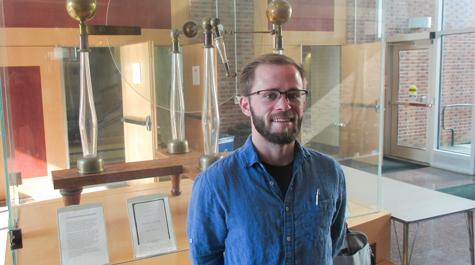‘Theory guy’ Colin Egerer selected for elite Department of Energy program
Colin Egerer describes himself as a “theory guy,” but he’s working at one of the world’s foremost facilities for physics experiments.
In fact, Egerer will join a whole department of theory people at the Jefferson Lab. He’s a Ph.D. student in William & Mary’s Department of Physics, but will spend much of his time down in Newport News at JLab, supported by a program of the U.S. Department of Energy.
“JLab is an experimental facility; they do some of the most precise low-energy nuclear experiments in the world,” Egerer said. “Any strong experimental effort is supported by constant interaction with a strong group of theorists. ”
He is one of only 60 grad students to be selected in 2018 for the DOE’s Office of Science Graduate Student Research (SCGSR) Program. The program’s goal is to support graduate-student research at JLab and other DOE facilities.
Egerer will be working on a dissertation related to arriving at a better understanding of the makeup of atomic nuclei. Each proton and each neutron is made up of smaller particles called quarks, bound by gluons. The quark-gluon assembly is bound through a fundamental interaction known simply as the strong force. It’s the focus of Egerer’s work — and of much of the work at JLab.
The descriptive theory of how the strong force acts is known as QCD, or quantum chromodynamics. Egerer says he’s not only a theory guy, but also a “QCD guy” and even more specifically, a “lattice guy.” He explained that lattice QCD is a quantitative approach that works at low energies.
“We're dealing with low energies, the energies responsible for the assemblage of quarks and gluons into protons, neutrons and other particles. These dynamics are ultimately responsible for the binding of protons and neutrons into nuclei, and the reality we interact with on a daily basis.” he explained.
Egerer went on to say that at such low energies, the pencil-and-paper calculations used by theorists just don’t work. “So, that necessitates my work, to simulate the behavior of the strong nuclear force on supercomputers.”
Egerer’s advisor in the William & Mary physics department is Professor Kostas Orginos. Science is increasingly a collaborative endeavor and QCD is an especially collaborative field. That’s why, even in this age of constant and instant communication, Egerer believes it’s better to be on site at JLab, where he will work with David Richards and other theorists.
“The benefit of being down there and working in the theory center is being able to converse with world renowned phenomenologists as well as people who have developed the software I’ll be using,” Egerer explained.
The SCGSR award will go a long way toward facilitating Egerer’s work at JLab. It provides support for travel to and from the lab, as well as a monthly stipend for general living expenses.
















